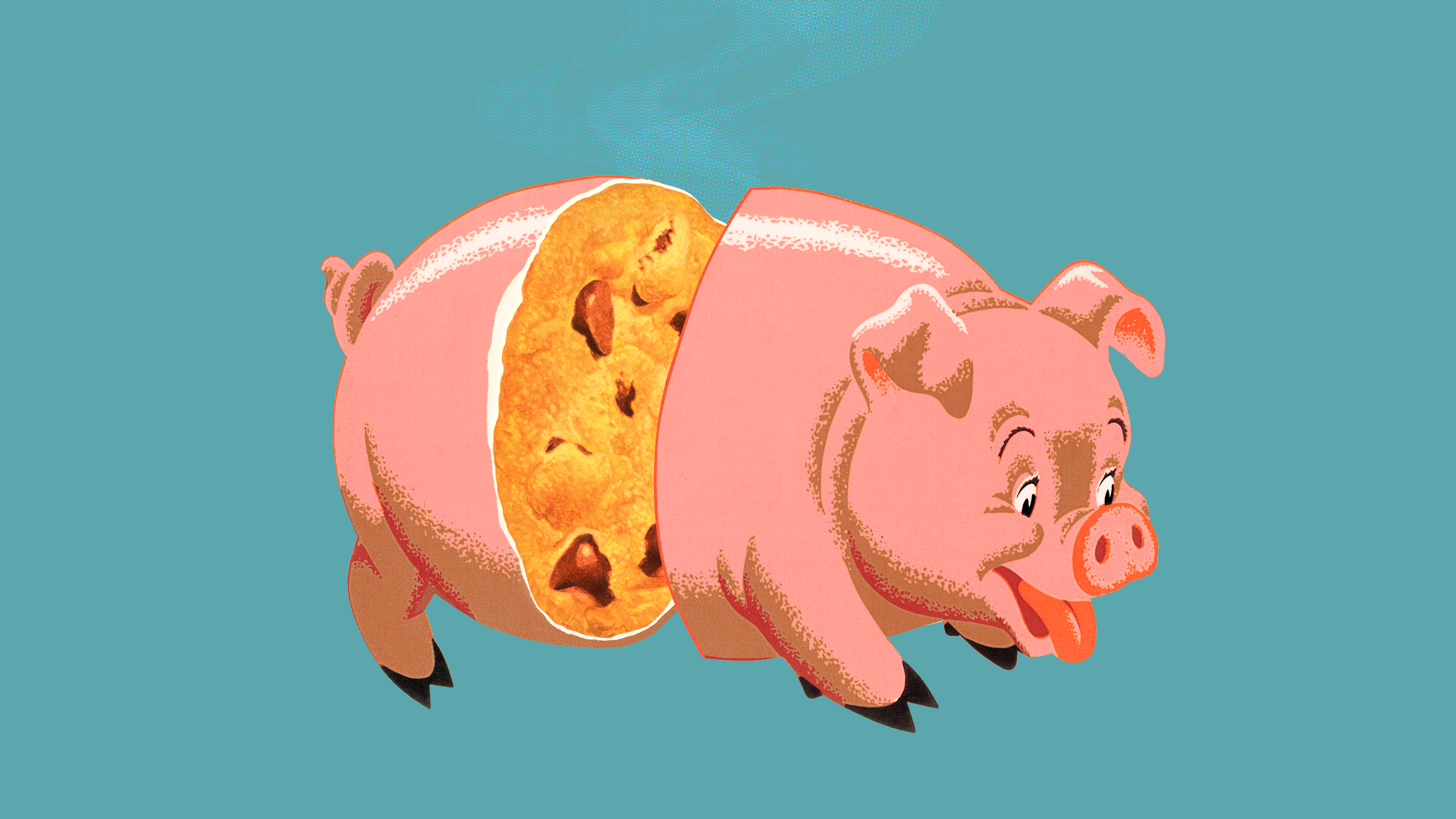Pig Cookies So Good You'll Be Bacon Them All Season Long
Christmas pigs might not have the PR team of a reindeer like Rudolph or a donkey like Dominick; they may not give you the warms and fuzzies like teddy bears in Santa hats or silly-willy penguins wrapped in comically oversized scarves. But pigs have been celebrating the holidays centuries before any of those cutesy seasonal mascots ended up on your pajama pants and cookie platters—in fact, they've been celebrating Christmas since before it was even Christmas.
The birth of Jesus Christ of Nazareth more than likely did not occur anywhere near December 25—there are no records of his birth date, and winter is cold enough in Israel that you're not going to see shepherds wandering about. What does happen near December 25 is the winter solstice, the day that the sun disappears around 4 p.m. and people start freaking out. Ancient Romans celebrated the festival of Saturnalia, opening the festival with the ritual sacrifice of a young pig to their god of time; celebrations featured roasted suckling pigs as the centerpiece of their many festive banquets. Pigs were ritually sacrificed in the solstice celebrations of the Germanic tribes of Northern Europe, the Picts of Scotland, the Celts of Ireland, the Saxons of England, the Vikings of Scandinavia. When the pagan solstice transformed into a Christian holiday, pigs were no longer sacrificed to gods—they were sacrificed for dinner.
Pigs are still poking around in many cultures' holiday traditions. In Sweden, small pigs are woven from straw and hung on the Christmas tree. Norwegians enjoy pigs made from marzipan. In Britain, pigs were turned into mince pies with dried fruit and spices; as the centuries went on and tastes changed, the pork was eventually omitted and the modern Christmas pudding was born. Children in Roman Catholic Slovakia are told that if they're able to make it through Christmas Eve without eating a single bite, then after midnight mass they'll be able to see a golden pig flying through the sky. (What does the golden pig do? Mostly just disappoints children by never showing up.)
In America, our Christmas pig worship is limited to Miss Piggy's tour-de-force performance as Mrs. Bob Cratchit in A Muppet Christmas Carol and, for some, the traditional ham. Shouldn't we put a bit more swine in our season? Our nation has a bacon version of everything; surely we should be able to muster up the enthusiasm to sacrifice some pigs around the solstice, just in case the Old Gods of Winter are still hanging around somewhere, granting wishes and smiting heathens.
This Christmas cookie is smoky, salty, and savory, with a sweet glaze just like the one you slap on your Christmas ham. Packed in a nice box, they're a great homemade gift to take to holiday parties, where you can regale the room with stories about pig sacrifices through the ages. Everyone will be impressed with how smart you are, as well as your superlative baking skills. You'll be the toast of the town. The Old Gods are already working their magic on you.

Pig Cookies
Makes approximately two dozen cookies
For the cookies:
- 1/2 lb. thick cut bacon, cut into 1" pieces
- 1/4 lb. deli ham, preferably Boar's Head Bourbon Ridge Ham
- 1 1/2 cups flour
- 1/2 cup oat flour
- 1/4 cup brown sugar
- 1/8 tsp. clove
- 3/4 cup (1 1/2 sticks) butter, cut into pieces
- 1 egg
- 1/2 tsp. pink food coloring
- 1 cup brown sugar
- 1/2 cup orange juice
- 1/2 cup honey
- 1 tsp. cinnamon
- 1/2 tsp. dry mustard powder
- 1 tsp. Dijon mustard
For the glaze:
Preheat the oven to 300 degrees.
Put the bacon into an uncovered baking dish; bake for one hour to slowly render the fat, stirring occasionally (it should not get crispy). Strain 1/4 cup of fat into a mug; put it into the freezer for 10 minutes to solidify. Take 1/3 cup of the chopped bacon and set aside; the rest of the bacon and bacon fat can be wrapped up and saved for another use.
While the bacon is rendering, line a baking sheet with parchment paper and lay out the ham, crimping as needed to make it all fit. Bake for 20 minutes, then move the ham to a plate lined with paper towels to drain and cool completely.
Put the bacon, ham, and cold bacon grease into the bowl of a food processor with the remaining cookie ingredients and pulse until it forms a solid ball of evenly colored dough. Loosely wrap the dough in plastic wrap, pat down into an 8" x 8" square, and refrigerate for 30 minutes. While you wait, line two baking sheets with parchment.
On a lightly floured cutting board, roll out the dough to a thickness of 1/4", then use cookie cutters to stamp out little pigs. Re-roll the scraps and repeat until all the dough is used up; arrange pigs on cookie sheets with at least 2" of space in between.
Pop the baking sheets into the refrigerator or freezer for a few minutes to firm up the dough so that when you poke it with your finger it does not leave a mark. Bake the cookies for 20 minutes, then pull out of the oven and allow to cool for five minutes.
Brush the cookies with glaze, then return to the oven for 3 minutes to set. Move the cookies to a wire rack and cool completely.
To make the glaze
Whisk together all the ingredients in a non-reactive saucepan and clip on a candy thermometer. Cook over high heat til the glaze reaches thread stage (230 degrees Fahrenheit). Turn off the heat and keep in a warm place until you're ready to glaze the cookies. If it hardens, return it to the stove over a medium flame until it liquefies.
